Using Picture Books to Teach Voice in Writing
Voice. It’s in every good piece of writing, but it’s a tad elusive to define and teach. Using picture books to teach voice in writing can help, though, and that’s what you’ll learn here.
Writing that connects with readers has a voice. Writing that makes you feel emotion has a voice. When it comes to life, writing has a voice. Writing that sounds unique or comes from the heart has a voice. Voice is the distinct personality of any writing.
That description sounds a lot like living literature, doesn’t it? Yes, exactly! If we don’t want to read twaddle, we shouldn’t care to write it either. That’s where learning to train the voice comes in.

This post contains affiliate links.
What is the voice in writing?
Some people might describe voice as the mood or tone of a piece of writing. While the mood or tone is, indeed, impacted by the voice – the actual voice is something just a little bit more. It’s how words are crafted to create the mood or tone of the writing.
See, I told you. The definition is a little elusive.
No worries, though. I think by using several picture books as mentor texts, it becomes easier for students to develop an understanding of voice and begin using it better in their writing.
P. S. Besides teaching voice through writing, picture books have the unique ability to teach visual voice in their illustrations, too.
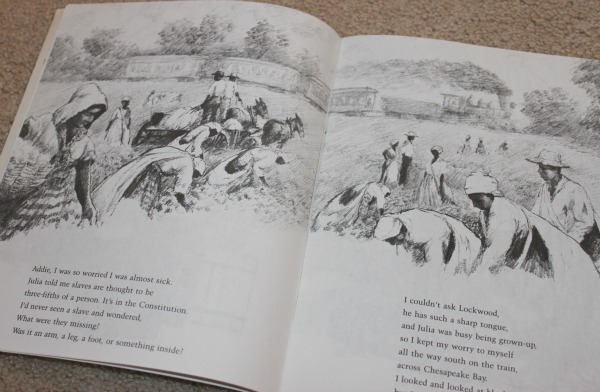
Using Picture Books to Teach Voice
Below, I will share several picture books and lesson ideas for using the books as mentors to help students learn to write with a voice. However, simply reading mentor books followed by discussions can work just as well.
When choosing the discussion approach, the main question you can ask after reading a mentor text is “Where do you find the voice? Is it in the general tone of the author/narrator? Or, is the voice coming from a character or multiple characters?”
The Voice in a Book Can Evoke Feelings
What can your students look for when asked the question, “Where do you find the voice?” Ask them to pay attention to feelings that are evoked within themselves while reading.
When books make you laugh out loud or shed a few tears, they have a voice. If you you feel strong or afraid, they have a voice. When you feel sorry for a character or a situation, you’ve been affected by the voice.
Here are a few great examples of books that set out to stir your emotions:
The Monster at the End of This BookLilly’s Purple Plastic PurseNettie’s Trip South (Aladdin Picture Books)When I Was Young in the Mountains (Reading Rainbow Books)
The Monster at the End of This Book by Jon Stone
Lily’s Purple Plastic Purse by Kevin Henkes
Nettie’s Trip South by Ann Turner (an excellent book about slavery)
When I Was Young in the Mountains by Cynthia Rylant
How To Find Voice within Emotional Picture Books
Here is an example to help you use a picture book to identify personal emotions and recognize them as a good use of the author’s voice in writing.
Discussion Activity: What emotions are the characters trying to make you feel? How do the characters elicit the feelings of the reader? In other words, what tactics are they using to stir those emotions?
Assigning Voice Lesson: This is a fun activity to help students learn to give voice to something that seemingly shouldn’t have a voice – colors! Read My Many Colored Days by Dr. Seuss and/or Hailstones and Halibut Bones by Mary O’Neill (one of my favorites.) Complete these three activities:
- Discuss how each author gives voice to the colors. Notice particular words and phrases. See how emotions are stirred. Notice if the color has taken on a personality through the words.
- Choose your own color and write a few notes or draw a few images to depict how that color makes you feel.
- Write a short poem about your color. The color has just been given a voice!

The Voice in a Book Can Share a Perspective
Two people can see the same situation very differently. When an author wants you to see (or even believe) a certain perspective, it’s often shared through voice. These books share perspective through voice beautifully:
The True Story of the Three Little PigsButterfly HouseTwo Bad AntsTown Mouse, Country MouseAlexander and the Terrible, Horrible, No Good, Very Bad Day
The True Story of the Three Little Pigs by John Scieszka
Butterfly House by Eve Bunting
Two Bad Ants by Chris Van Allsburg
Town Mouse, Country Mouse by Jan Brett
Alexander and the Terrible, Horrible, No Good, Very Bad Day by Judith Viorst
How To Find Voice by Looking at Perspective
Here is an example to help you use a picture book to look at the point of view to find the voice.
Discussion Activity: Perspective is otherwise known as point of view. How does the main character’s perspective from each book shape the story? Could the story be totally different from the perspective of a different character?
Perspective Lesson: Tell (or write) one story from two different perspectives. Choose from the scenarios listed below or create your own. Afterward, discuss major twists in the storyline based on the varied perspectives.
- There’s a snake in your yard. Tell one story from your perspective. Tell another from the snake’s perspective.
- It’s the day after Christmas. Tell one story from the perspective of a mom who gets her cluttered house back in order. Tell another from the perspective of the trash collector picking up the extra trash from the holiday festivities. Tell one more from the perspective of a child.
- It’s raining. Tell one story from the perspective of someone living near a creek where the rains have been pounding for four days straight. The another story from the perspective of a farmer who hasn’t seen rain in two months.
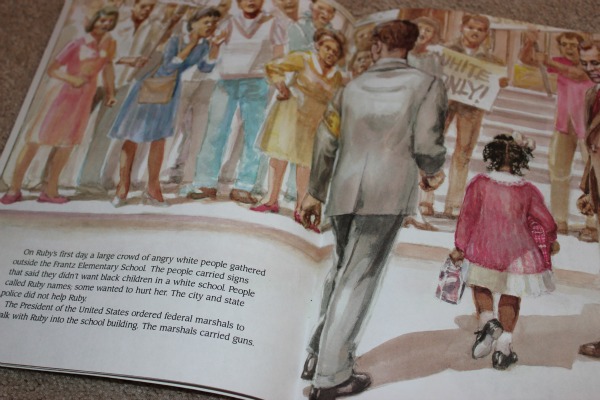
Voice in a Book Can Show Personality Traits
It makes sense that the voice of a character in a book would share much about his or her personality. That’s exactly what these books demonstrate – very intriguing personalities:
My Rotten Redheaded Older Brother (Aladdin Picture Books)The Paper Bag Princess (Classic Munsch)Officer Buckle & Gloria (CALDECOTT MEDAL BOOK)The Story Of Ruby Bridges: Special Anniversary EditionThe Raft
My Rotten Redheaded Older Brother by Patricia Polacco
The Paper Bag Princess by Robert Munsch
Officer Buckle and Gloria by Peggy Rathmann
The Story of Ruby Bridges by Robert Coles
The Raft by Jim LeMarche
How To Find Voice by Looking at Personalities of Book Characters
Here is an example to help you use a picture book to examine a character’s personality to help you find the voice of a book.
Discussion Activity: Whether you read one or all of these books, go through the following discussion for each book that you read.
“Which character from the book has a personality that stands out the most? How would you describe the personality? Share examples from the book that support your view of the personality. How has the author crafted the words to shape the character’s personality? Did anything happen in the storyline to reshape the personality?”
Personality Traits Lesson: A little acting can go a long way in developing personalities in writing. This quick lesson is fun, too!
- Write several personality traits on index cards: rude, angry, sweet, shy, selfish, energetic, bossy, confident, studious, excited, etc.
- Ask your student to develop a character in his mind. Give the character a name and share his or her physical characteristics. Don’t define anything about the character’s personality yet.
- Draw one personality index card. Tell a short story about the character in which this one main personality is portrayed.
- As you draw new cards, you can choose from two possibilities: First, change the character’s personality entirely and tell a new story with the new personality. Second, add a new layer to the personality and continue telling the original story where the character now portrays two (or more) personalities.
- After some practice with this exercise, transition to a written short story that focuses on building a character with clear personality traits.
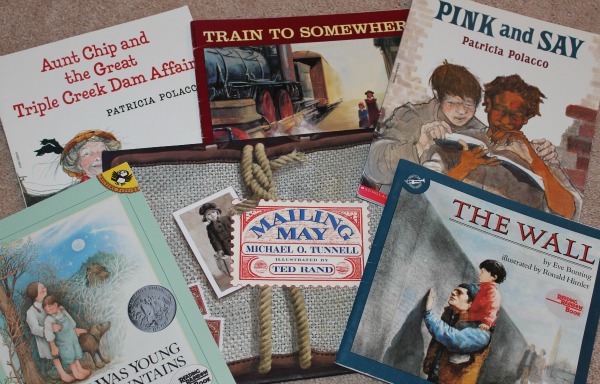
Other Picture Books To Teach Voice
There are plenty of wonderful, living picture books that can be used to recognize voice, internalize how it’s used, and mimic it in writing. The books below are some great options.
Henry’s Freedom Box: A True Story from the Underground RailroadTar BeachFly Away HomeWe Had a Picnic This Sunday PastMrs. Katz and Tush (Reading Rainbow)Pink and Say
Henry’s Freedom Box by Ellen Levine
Tar Beach by Faith Ringgold
Fly Away Home by Eve Bunting
We Had a Picnic This Sunday Past by Jacqueline Woodson
Mrs. Katz and Tush by Patricia Polacco
Pink and Say by Patricia Polacco
Stellaluna 25th Anniversary EditionTrain to SomewhereThe Wall (Reading Rainbow Books)The Velveteen RabbitThe Rough-Face GirlThe Relatives Came
Stellaluna by Janell Cannon
Train to Somewhere by Eve Bunting
The Wall by Eve Bunting
The Velveteen Rabbit by Margery Williams
The Rough-Face Girl by Rafe Martin
The Relatives Came by Cynthia Rylant
Aunt Chip and the Great Triple Creek Dam AffairMailing MayThe Emperor’s New Clothes (Folk Tale Classics)Owl MoonVerdi
Aunt Chip and the Great Triple Creek Dam Affair by Patricia Polacco
Mailing May by Michael O. Tunnell
The Emperor’s New Clothes by Hans Christian Anderson
Owl Moon by Jane Yolen
Verdi by Janell Cannon
Another Activity To Use Picture Books To Teach Voice in Writing
Here’s a fun idea to use with any of the books mentioned above.
- Read the book without showing your student any pictures.
- As you read, the student should picture the main character and note facts about his or her personality traits, character qualities, attitudes, and physical characteristics – even down to their age and what they might wear.
- Your student should explain their observations about the character and give evidence from the book to support their view.
- Explain that the “picture” of the character was built not only by descriptions that may have been written directly in the book but through the impressions given by the voice of the text.
- Now, your student gets to do some writing! Using the same character from the book you just read, your student must craft a new story. The setting and/or situation should be entirely different, but the character and all his or her attributes should be the same.
- Note: When first learning about voice, it’s best to only expect a paragraph or two for the new story. Expand the length expectations as you see fit.
Need a little more direction in teaching with this method?
I taught a practical video class for parents and teachers to help!
If you’ve enjoyed this article, I know you’ll enjoy the others in this series, too!





















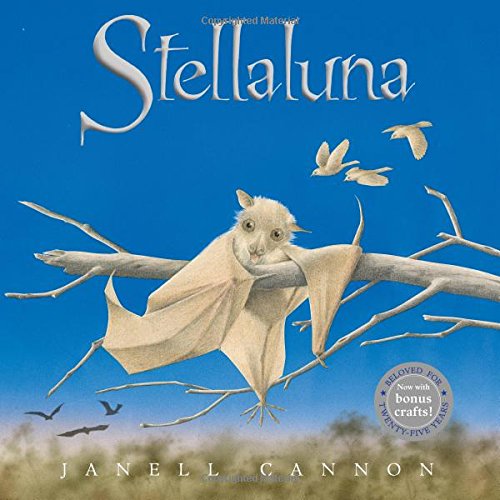











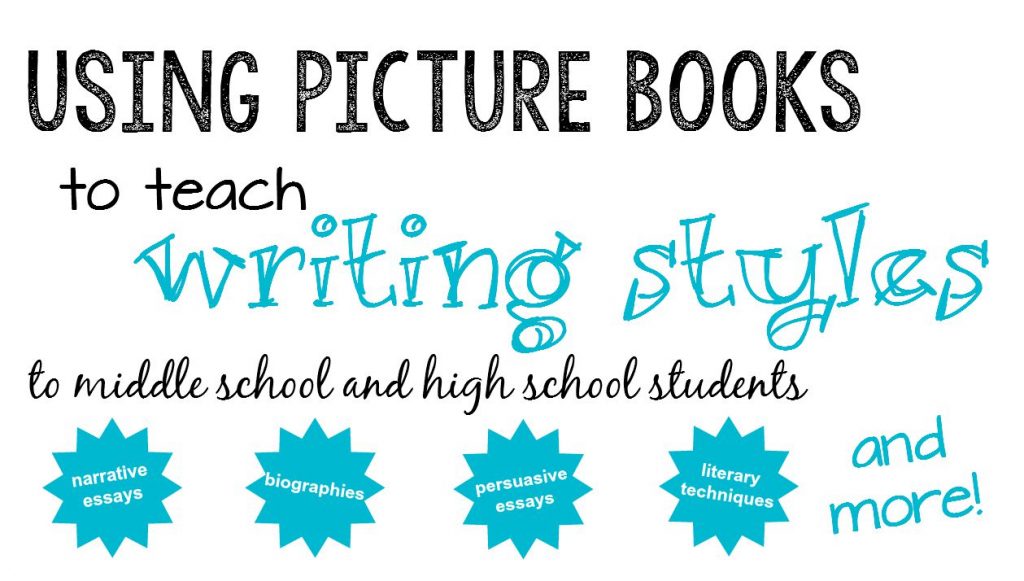
Thanks for this series. Picture books are a favorite of mine, and I am always happy to find new ways to use them while teaching (gives me an excuse to keep buying new books) I have used several of your suggestions with great results. We are entering a poetry unit and I would love to see your suggestions for that genre. Thanks for sharing.
Ah, poetry. It’s on the to-do list. I’ll try to get to it before too long. 🙂 (P.S. I always love hearing from fellow bookaholics.)
Great ideas! My kids aren’t in high school yet, but I am so glad to learn about meaningful ways to continue incorporating pictures books throughout their educations. I’d like to invite you to link up with our Literary Musing Mondays Linkup #LMMLinkup. https://www.foreverjoyful.net/?p=731
Great ideas! I love using literature to teach writing. Passed this on to my daughter who wants to each a Literature and Art class next year to young homeschoolers.
I love this. This year I will have three teens in the house. And I am always looking for new ways to teach them. Mix it up a little. And I just can’t seem to get enough of picture books lately. I’m loving this list, of some old favorites to new ones. Thanks! So glad I found you 🙂
I can never get enough picture books in my life, Liz! LOL Enjoy your teens!!
Thank you so much for this information. Lots of the books you mention are available here and fit with the Australian curriculum. I, too cannot collect enough picture books and my students are soaking up my own enthusiasm. I look forward to any inspiration on poetry as well. I’m so glad I found you!
You know, I think OUR enthusiasm about learning might make the biggest difference of all in homeschooling!
Love your ideas! Thanks for this great post.